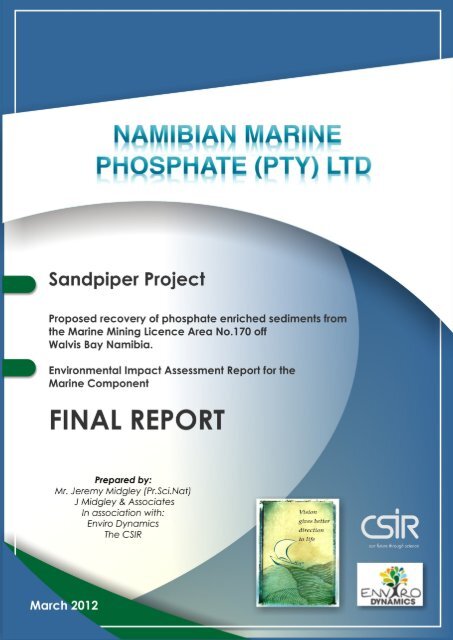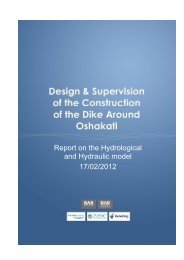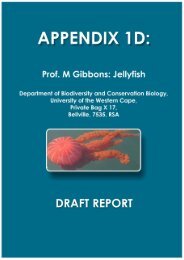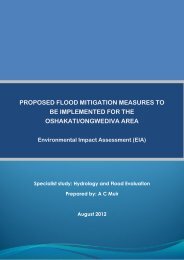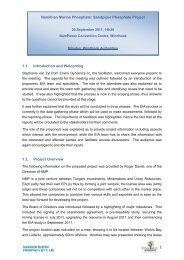Cover Summary - Enviro Dynamics Namibia
Cover Summary - Enviro Dynamics Namibia
Cover Summary - Enviro Dynamics Namibia
You also want an ePaper? Increase the reach of your titles
YUMPU automatically turns print PDFs into web optimized ePapers that Google loves.
NEED FOR THE PROJECTPROJECT CONCEPTUALISATIONLOCATIONEIA PROCESSCONSIDERATION OF THE “NO GO” OPTIONMINING SYSTEM ALTERNATIVESASSESSMENT OF THE IMPACTSCUMULATIVE IMPACTSASSESSMENT OF THE MANAGEMENT PLANOVERALL ASSESSMENTIVIVVVVIVIVIXIXIXIFinal Report<strong>Namibia</strong>n Marine Phosphate (Pty) Ltd.Page iii
estimated at 1,832 Mt Mt (1.832 Billion tonnes) at15 % phosphate (P 2 O 5 ) content 7 . Prefeasibility andscoping studies completed by NMP in November2010 identified that dredging (using a TrailingSuction Hopper Dredger) 5.5 Mt of the phosphateenriched sediments annually would yield 3.0 Mt ofexport grade ‘phosphate rock concentrate’Concluding comments from these studiesestablished a robust economic project modelwhich supported and justified the development ofa Definitive Feasibility Study (DFS) subject to amining licence being issued.A full definitive feasibility study has beenembarked upon with envisaged completion duringthe first quarter of 2012. The feasibility study issupported by integrated <strong>Enviro</strong>nmental ImpactAssessments that address the marine andterrestrial components respectively.The main project elements are:• Dredging annually 5.5 Mt of phosphateenriched marine sediments from 190 to 275 mwater depths;• Transporting this ‘slurry’ in the dredger to anoffshore discharge buoy – pipeline(approximately 1.2 km offshore) and pumpingthe material to a coastal buffer pond, locatedto the south of the Walvis Bay salt works;• Reclaiming the slurry from the buffer pond andscreening out the shell fraction;• Pumping the slurry along a 26 km pipeline tothe processing plant located 5 km to the eastof Walvis Bay;• Processing (washing) the slurry to separate theRock Phosphate from the fines, and• Exporting the rock phosphate to Internationaldestinations through the Port of Walvis Bay.LOCATIONThe marine phosphate project (“Sandpiper”) islocated on the <strong>Namibia</strong>n continental shelfapproximately 120 km south southwest of WalvisBay. The eastern boundary of the Mining LicenceArea is approximately 40-60 km off the coast(directly west of Meob Bay and Conception Bay).The water depths in the licence area range from180 to 300 m. The Mining Licence Area is25.2 km wide (greatest width) and 115 km long(longest length) and covers an area of 2233 km 2 .Three target recovery areas have been selectedwithin the total mineral resource area, two ofwhich are 22 x 8 km in size and one at 11 x 6 km(totalling 418 km 2 ) which are the particular focusof this evaluation. Of this resource, approximately3 km 2 will be mined in the selected target recoveryareas annually over the 20 year licence period toachieve the targeted 3 Mt pa dry productproduction target.The Mining Licence Area is located within theNorthern Benguela of the Benguela Current LargeMarine Ecosystem, on the outer shelf to the southwest of Walvis Bay. The Benguela displays a highdegree of variability over a broad spectrum of timeand spatial scales. It is an important centre ofmarine biodiversity and marine food production.Its distinctive bathymetry, hydrography, chemistryand trophodynamics combine to make it one of themost productive ocean areas in the world. Thishigh level of primary productivity of the Benguelasupports an important global (and local) reservoirof biodiversity and biomass of zooplankton, fish,sea birds and marine mammals, while near-shoreand offshore sediments hold rich mineraldeposits 8 . These living and non-living resources areof economic and strategic importance to <strong>Namibia</strong>.EIA PROCESSTo ensure that the project complies with therequirements of the <strong>Enviro</strong>nmental ManagementAct (No. 7 of 2007) it is necessary to conduct an<strong>Enviro</strong>nmental Impact Assessment (EIA) andcompile an <strong>Enviro</strong>nmental Management Plan(EMP). This process and its outcomes then allowsfor the Ministry of <strong>Enviro</strong>nment and Tourism (MET)in association with the relevant ministries to makean informed decision as to whether or not theproject should receive an <strong>Enviro</strong>nmentalCertificate and be allowed to proceed.7 Established to the Joint Ore Reserve (JORC) standards ofthe Australian Stock Exchange (ASX)8 Shannon, L.V, and O’Toole, M.J.: Sustainability of theBenguela: ex Africa semper aliquid novi.Final Report<strong>Namibia</strong>n Marine Phosphate (Pty) Ltd.Page v
Given the marine and terrestrial operationalenvironments encompassed by this project twoseparate yet integrated EIA processes are beingconducted.The key issues to be addressed in the EIA weredetermined through a scoping process thatincluded inputs from governmental authorities, thepublic, business, NGOs, and the EIA team. Thefollowing categories of issues were identified:• Governance;• The EIA process;• Biogeochemical impacts;• Benthic impacts;• Marine fauna – flora impacts;• Cumulative impacts;• Socio-economic impacts, and• Project impacts.CONSIDERATION OF THE “NO GO”OPTIONIn common with the exploitation of all mineraldeposits there is no alternative to the proposedproject. It has been evaluated as a viable operationin respect of all corporate responsibilities, liabilitiesand requirements. The final decision as towhether the project will be permitted to proceedrests with the Authorities.MINING SYSTEM ALTERNATIVESWhilst the “No Go” option is not evaluated inmining project EIAs, alternatives have beenconsidered in respect of identifying the optimalmining system to recover the phosphate-richmarine sands. Of the seven systems evaluated(trailing suction hopper dredger (TSHD), wirelinedredge pipe, large diameter drill, mechanical grab,fall pipe and remotely operated vehicle (ROV), andflexible hose and ROV), the TSHD is identified asthe system that optimally minimises the projecttechnical risk and meets the project’s commercialrequirements. The dredger, with its sedimententrainment ‘drag head,’ its in built ‘hopper’(sediment slurry entrainment ‘cargo’ space)carrying capacity and established (and tested)operational standards of practice (includingenvironment and safety) establishes this type ofrecovery system as being the preferred method.ASSESSMENT OF THE IMPACTSFour specialist studies were undertaken to addressthe potential impacts of the proposed project,these are:• Fisheries, mammals and seabirds, five impactsare evaluated;• Changes to marine water quality, elevenimpacts are evaluated;• Benthos, nine impacts are evaluated; and• Jellyfish, four impacts are evaluated.The Specialists assessments are reported in full inAppendix 1, presented in Chapter 7 (environmentalImpact Assessment), and summarised here below.These assessments are based on some in fieldmeasurements (benthic studies) as well as publiclyavailable published information and/or data. Thisincludes data provided by MFMR as well as theConfederation of <strong>Namibia</strong>n Fishing Associations. Aswith all data sets, there are varying associateddegrees of confidence. Notwithstanding, given theavailable data, this report provides the results andrecommendations from the specialist evaluation ofthe body of reviewed scientific literature, extensivefisheries data as well as information / datacollected from the licence area. The assessmentsof the impacts by the specialists are:Final Report<strong>Namibia</strong>n Marine Phosphate (Pty) Ltd.Page vi
FISHERIES, MAMMALS AND SEABIRDS - Mr. D JappImpact: 1Significance:Mitigation:Impact: 2Significance:Mitigation:Impact: 3Significance:Mitigation:Impact: 4Significance:Mitigation:Impact: 5Significance:Mitigation:The impact on fishing operations of phosphate dredging on the main <strong>Namibia</strong>nfishing sectors; a) hake trawl and b) hake longline, c) monk trawl d) horse mackerelmid-water trawl, and e) small pelagic purse seine fisheries. The fishing sectors will notbe able to operate in certain areas due to 1) actual mining operations due todredging operations and vessel activities, 2) associated sediment plumes 3) exclusionzones around the dredging site and 4) increased levels of maritime traffic associatedwith the dredging operation.Medium - the project design might require modification to accommodate certain fishingoperations.Consider options to minimise impact on fishing operations for example options withrespect to spatial and temporal area closures.The impact of phosphate mining on the ecologically important demersal andpelagic fish species. The impact will result in the redistribution and/or displacementof hake, monk, horse mackerel, sole, orange roughy, bearded goby populations andsmall pelagics because of 1) actual recovery activities due to dredging operations andvessel activities 2) habitat disturbances and the removal of substrate and 3) sedimentplumes (turbidity)Medium - the duration of the impact is permanent but recovery of fish populations inthe area may occur in the long term. The intensity is minor to moderate and the extentis confined to the MLA and Zone 1In terms of the ecosystem as a whole there are no particular mitigation measures thatcan be implemented.The impact of phosphate dredging on the recruitment of key commercial fish stocksa) hake b) horse mackerel c) monk and d) small pelagic species. The dispersal andsurvival of juveniles, eggs and larvae are effected by 1) physical disturbance of thefishing grounds and 2) sediment plumes (turbidity)LowNo practical mitigation measures are possible.The impact of phosphate dredging on species diversity. Dredging operations willresult in a reduction or loss in biodiversity because of the 1) actual dredging andvessel operations, 2) the habitat destruction and the removal of substrate and 3)sediment plumesLow – the impact on species diversity is not expected to influence project designprovided the current area limitations are maintained. Expansion of dredging in thecurrent or alternate lease areas without baseline monitoring of biodiversity andcontrols must be a prerequisite to the commencement of operations.No practical mitigation measures are possible.The impact of phosphate dredging on seabirds and marine mammals. Dredgingoperations will result in the displacement and/or redistribution of seabirds andmammals because of 1) disturbance of the ecosystem and availability of feed and 2)physical disturbance of the dredgers including noise pollutionMedium - Most sea birds and mammal species found in the area will be affected butat a low level due to the limited extent of the dredging operations.Maintain a bridge watch for large mammal species. Although the dredger will havelimited manoeuvrability a protocol to limit interaction should be followed – in thisregard JNCC guidelines are recommended. Lighting control to minimise night strikes ofbirds.Final Report<strong>Namibia</strong>n Marine Phosphate (Pty) Ltd.Page vii
MARINE WATER QUALITY - Dr. R CarterImpact: 1Significance:Mitigation:Impact: 2Significance:Mitigation:Impact: 3Significance:Mitigation:Impact: 4Significance:Mitigation:Impact: 5Significance:Mitigation:Impact: 6Significance:Mitigation:Impact: 7Significance:Mitigation:Impact: 8Significance:Mitigation:Impact: 9Significance:Mitigation:Potential deterioration in water quality from discharges to sea of wastes such as oilywater, sewage, food, grey water, from the dredger.NoneEnsure vessel discharge/retention systems and procedures are in good working orderand do not malfunction.Alien marine species may displace indigenous species and reduce indigenousbiodiversity and/or affect aquaculture and/or aquaculture products.Follow IMO guidelines on ballast water management.None. (Alien introductions would become “improbable” but if introductions were tooccur the consequences (significance) would still be high).Dredging generates plumes of suspended sediments that adversely affect organisms inthe water columnLowBuilt in, with discharge below dredger’s hull (10-15 m below sea surface)Sulphidic sediment pore-water entrained in the dredged sediment is discharged withthe over-spill water thereby affecting organisms in the water columnLowNone possibleHypoxic/ anoxic bottom water is entrained in the discharged overflow water soreducing dissolved oxygen concentrations in the upper water column where it canaffect organisms.NoneNot applicableIncreased availability of nutrients (ammonium and phosphorus) promote phytoplanktongrowth. Following senescence, the phytoplankton will add to the particulate organicmatter flux to the seabed eventually further reducing dissolved oxygen concentrationsthrough remineralisationNoneNone possibleTrace metals (cadmium and nickel) bound in the dredged sediment are discharged withthe over spill water thereby affecting organisms in the water column.LowNone possibleTrace metals held within the target dredge area sediments are remobilized; theybecome bio-available through exposure to the overlying water during dredging withdeleterious effects on filter and/or deposit feeding benthos.LowNone possibleSulphidic sediment pore-water is exposed by dredging, and the flux of dissolved H2Sinto the lower water column is increased, so affecting benthos.LowNone possibleFinal Report<strong>Namibia</strong>n Marine Phosphate (Pty) Ltd.Page viii
Impact:Significance:Mitigation:Impact:Significance:Mitigation:Impact:Significance:Mitigation:Re-deposition of particles in the overflow plume causes smothering of benthicorganisms, particularly in the depo-center on the continental slopeLowNo mitigation necessaryDredging may mobilise dissolved nutrients from the sediments which could be releasedinto the water column with the overflow. The increased nutrient level may result inextensive phytoplankton blooms, which upon death cause aggravated decompositionrates leading to anoxic conditions at the seafloor.LowNo mitigation necessaryRelease of hydrogen sulphide from the sediments affects benthic communitiesLowNo mitigation necessaryJELLYFISH - Prof. M GibbonsImpact:Significance:Mitigation:Impact:Significance:Mitigation:Impact:Significance:Mitigation:Impact:Significance:Mitigation:Blocking of vessel seawater intake system by dense surface aggregations of jellyfish.Dense surface volumes of jellyfish have been known to block the seawater intakes. Thisincoming seawater is used to cool the vessel’s engines and any blockage of the intakesystem could cause the engines to overheat and fail, if remedial action is not taken.LowIn the case of blockage, jellyfish will have to be physically removed or flushed fromthe system. Sailing the vessel to areas with less dense aggregations of jellyfish.Forward looking sonar could be installed on the vessel to identify dense masses of subsurfacejellyfish during operations. A “jellyfish observer” on deck should be able toidentify jellyfish aggregations at the surface.Hydrogen sulphide released from dredge sediments causing mortalities to jellyfish.LowNo mitigation is presentedLean water overflow from the vessel generates a tailings plume of fine sediments whichsettle out through and are dispersed in the water column. These fine sediments ifpresent in sufficient quantities may cause mortalities to jellyfish, though this isconsidered unlikelyLowNo mitigation is presentedRemoval of seabed sediments will change the nature of the sediment surface. Jellyfishpopulations are known to increase in areas where there is an increase of hardsubstrate. Typically this occurs where rock, concrete or iron structures are erected. Theremoval of the upper relative soft layers of sediment, leaving a relative hard clayfootwall surface may provide such a hard surfaceLowNone: If between 10 - 15 % of the original thickness of the sediment is not recovered,there will sufficient soft-substrata to preclude polyp settlement.Final Report<strong>Namibia</strong>n Marine Phosphate (Pty) Ltd.Page x
CUMULATIVE IMPACTSThere is a growing amount of shipping activity inthe <strong>Namibia</strong>n Exclusive Economic Zone (EEZ)including, Fishing (<strong>Namibia</strong>n and foreign) vessels,Oil tankers en route from Angola to China, generalcargo vessels, vessels exploring/mining fordiamonds and industrial minerals as well asactivities relating to oil and gas includingexploration deep seismic survey vessels and oil rigsAccording to data provided by MFMR and CNFA, aproportion of the seabed within the vicinity of theMining Licence Area (MLA) is already beingrepetitively disturbed by trawling, primarily formonk fish. It is estimated from trawl records(appendix 1a) that for 2007 – 2009, 26,022 hoursof monk trawling was conducted in the generalvicinity of the MLA.The proposed dredging will remove sediments upto a depth of 3 m below the sea floor over anapproximate area of up to 3 km 2 annually whichrepresents a total of approximately 60 km 2 for a 20year life of mine (which is the current term of theML tenure).In order for the cumulative and additive effects ofall relevant marine activities on the <strong>Namibia</strong>ncontinental shelf to be comprehensivelyaddressed, an integrated assessment of all the userimpacts needs to be undertaken. While this level ofinvestigation lies within the responsibility of thegoverning entity, it is considered that the BenguelaCurrent Commission could provide the platform forthis important collaborative initiative.ASSESSMENT OF THE MANAGEMENTPLANFollowing receipt of feedback from the review ofthe Draft EIA/EMPR, in order to ensure theeffective implementation of mitigation andmanagement actions the Final <strong>Enviro</strong>nmentalManagement Plan (EMP) has now been preparedfor the proposed project. This incorporates adetailed verification programme and long termmonitoring protocol compiled by the Specialistscientists that have contributed to the EIA. Theverification programme is to be completed prior tocommencement of dredging .The Final <strong>Enviro</strong>nmental Management Plan reporthas been produced to provide the framework toensure that :• all corporate, legal and socio-economicrequirements are complied with. This appliesequally to subcontracting companies;• the authorities and I&APs are appropriatelyconsulted, advised and included in relevant ongoing project matters;• all vessel operations are managed inaccordance with <strong>Namibia</strong>n, vessel flag stateand International requirements as appropriateto the nature and location and scope ofactivities;• a programme of field work is carried out priorto commencement of dredging operations toprovide data for the verification of theSpecialists current conclusions andconsidered impact assessments .;• an on going monitoring programme isimplemented to assess the recovery and or recolonisationof the dredge areas after dredgingoperations have commenced.If the verification survey data show no significantdeparture from the specialists’ current conclusionsand assessments then these assessments will beconsidered to remain fully valid. Alternatively, if onanalysis of the site-specific validation data thereare any significant departures for the initialspecialist interpretations and assessments thenthose specific aspects of the EIA need to berevaluated and modified as may be deemedappropriate by the relevant specialist(s) and resubmittedfor approval.OVERALL ASSESSMENTThe significance of the potential impactsassociated with the proposed Sandpiper project fordredging of marine phosphate enriched sedimenthas been investigated and assessed by relevantappointed specialists in the <strong>Enviro</strong>nmental ImpactAssessment and independently audited by CSIR.Final Report<strong>Namibia</strong>n Marine Phosphate (Pty) Ltd.Page xi
The opinion of the specialist and the independentreviewer is that there are presently no identifiedissues of environmental significance to precludethe dredging of phosphate-enriched sedimentsfrom the Mining Licence Area No. 170. In order toverify these conclusions, a programme of workspecified by the relevant specialists, has beenincluded in the <strong>Enviro</strong>nmental ManagementProgramme that will be undertaken prior to thecommencement of dredging to substantiate thefindings provided in the impact assessment. Goingforward, all environmental matters will need tobe managed through the environmentalmanagement plan. These requirements areevaluated and detailed herein.In making a decision whether or not to issue an<strong>Enviro</strong>nmental Contract for the proposed project,the <strong>Namibia</strong>n government agencies and authoritieswill need to evaluate the overall costs and benefitsof the project. The primary purpose of this EIAprocess is to provide information that focuses onthe key issues and to assist the authorities inunderstanding the project in terms of its effect onthe natural environment, social impact andeconomic growth. Note, the latter two items areaddressed in detail in the EIA for the relatedterrestrial operations.In the final assessment it is important to note thesignificant benefits of this project. These are:• World phosphate resources: The SandpiperProject’s current mineral resource estimate of1,832 Mt at 15 % P 2 O 5 (JORC and NI43-101compliant) in ML170 alone, positions <strong>Namibia</strong>as seventh largest in terms of world phosphateresource. Phosphate (or Phosphorus) for whichcurrently there is no known substitute, is avital component of agricultural fertilizers andfeeds. This resource thus has potential tocontribute significantly not only to thesustained supply of <strong>Namibia</strong> but also worldfood production.• Macro-economic benefits: The marinecomponent of the project is relatively smalland will create local employmentopportunities for approximately 11 functions(there are a total of 37) onboard the vessel.From a local perspective, the employment andeconomic benefits from the marinecomponent of the proposed project arisemostly from the wider downstreamopportunities associated primarily with theport and vessel support services.By far the major economic benefit on local,regional and national levels, will be associatedwith the processing plant located in WalvisBay. The project’s socio-economic benefits areaddressed in the EIA/EMPR for the terrestrialcomponent. National macro-economicbenefits also include contributions togovernment revenue through rates, taxes androyalties.This environmental impact assessment is based oninformation about the Company’s current strategyfor the project development. If there is analteration in the nature, intensity or extent of theproposed activities then the nature andsignificance of identified impacts may also changeand will be duly re-assessed. In addition, any futureor greater understanding of key environmentalprocesses or changes in uses or activities in thisregion may also require reassessment of theseenvironmental impacts.In this report, the environmental impactassessment of the dredging of marine phosphatesconsiders those impacts arising from dredgingfrom within three target-recovery areas selectedfrom within the boundaries of Mining Licence AreaML170. It must be recognised that the anticipateddredging in the target recovery areas for dredgingin the Mining Licence Area ML 170 affects, only anextremely small portion of the total Benguelaecosystem on the <strong>Namibia</strong>n continental shelf. TheMining Licence ML170 Area (2233 km 2 ) has beenawarded for a 20-year period, from which annuallyapproximately 5.5 Mt of phosphate enrichedsediments are expected to be recovered from anarea of approximately 3 km 2 (I.e. 0.1% of the MLAarea).Excluding other marine activities (such as fishing,oil and gas exploration, general shipping), theMining Licence Area allocated to NMP is one ofmany Exclusive Prospecting Licences and MiningLicences already issued over the <strong>Namibia</strong>ncontinental shelf. Consideration should thereforebe given by the authorities to the cumulativeeffects of all exploration and mining by all minerallicence owners and operators. This cumulativeFinal Report<strong>Namibia</strong>n Marine Phosphate (Pty) Ltd.Page xii
assessment needs also to include other users ofthe marine environment as noted above.<strong>Namibia</strong>n Marine Phosphate (Pty) Ltd will remainresponsible for monitoring the impacts of theirdredging activities in their Mining Licence Area.Such impacts should be considered relative to theproportion of the ecosystem contained within theMining Licence Area, except where such impactsare shown to or are expected to extend beyondthese boundaries.Grateful acknowledgement is extended to the<strong>Namibia</strong>n Confederation of Fishing Associations fortheir facilitation of obtaining and providing currentfisheries data held by MFMR but not yet officiallyreleased or approved by MFMR. MFMR isrespectfully acknowledged for providingpermission to use the data provided via NCFA andfor their provision of the other fisheriesinformation presented in this EIA. Not allinformation requested from MFMR was provided.The I&APs who provided comment to both thescoping phase of this project and the review of theDraft EIA are acknowledged and thanked for theirconstructive input.Final Report<strong>Namibia</strong>n Marine Phosphate (Pty) Ltd.Page xiii
µg/lÅASXBCLMEBENIFITBenthicBODBIDBtCFCCH 4CODDemersalDFSDPECEIAEMPEMPR<strong>Enviro</strong>nment<strong>Enviro</strong>nmental ContractEPLGHGgrtH 2 SHopperHPI&APsIFAIMOISMISOParts per billionAngstronmAustralian Stock ExchangeBenguela Large Marine EcosystemBenguela <strong>Enviro</strong>nment Fisheries Interaction and TrainingSea bottom dwelling / environsBiological Oxygen DemandBackground information document: A document that provide summary of theproject with an emphasis on environmental processes.Billion tonnesChlorofluorocarbonMethane a gas found in marine sediments. Its eruption is reported to be acontributing factor to green house gases.Chemical Oxygen DemandBottom or near bottom dwelling.Definitive Feasibility StudyDynamic Positioning<strong>Enviro</strong>nmental Contract<strong>Enviro</strong>nmental Impact Assessment<strong>Enviro</strong>nmental Management Plan<strong>Enviro</strong>nmental Management Plan ReportThe surroundings in which the company operates, including air, water, land,natural resources, flora, fauna, humans and their interrelation.A legal agreement (based on the EMPR) issued and authorised by the Ministry of<strong>Enviro</strong>nment and Tourism, signed by <strong>Namibia</strong>n Marine Phosphate (Pty) Ltd andthe Ministry of Mines and Energy.Exclusive Prospecting LicenseGreenhouse gasesgross registered tonnageHydrogen Sulphide, as gas which is contained in the marine sediments of thisregion. (>4% in concentrations of the gas in air is fatal)A fully enclosed cargo hold space on dredging vessels where the dredge material istemporarily stored.Horse PowerInterested and Affected PartiesInternational Fertilizer Industry AssociationInternational Maritime OrganizationInternational standard for the safe management and operation of ships and forpollution preventionInternational Standards OrganisationFinal Report<strong>Namibia</strong>n Marine Phosphate (Pty) Ltd.Page xiv
Indicated resource Is that part of a Mineral Resource for which tonnage, densities, shape, physicalcharacteristics, grade and mineral content can be estimated with a reasonablelevel of confidence.Inferred resource Is that part of a mineral resource for which the tonnage, grad and mineral contentcan be estimated with a low level of confidenceJDNJan Du Nul NV – the Belgium dredging companyJORCJoint ore reserves committee. The Australasian Code for reporting of ExplorationResults, Mineral Resources and Ore Reserves. The Code is incorporated into theListing Rules of the Australian Stock Exchange (ASX)JVJoint VentureMETMinistry of <strong>Enviro</strong>nment and TourismMFMRMinistry of Fisheries and Marine ResourcesMLMining LicenceMLAMining Licence AreaMMEMinistry of Mines and EnergyMtMillion tonnesMWTC : DMAMinistry of Works Transport and Communication: Department of Maritime AffairsNatMIRCNational Marine Investigation and Research CentreNGOsNon Governmental OrganizationsNMP<strong>Namibia</strong>n Marine Phosphate (PTY) LtdNORMNaturally Occurring Radioactive Materials(P 2 O 5 ) PhosphatePAPer annumppmParts per millionP&IProtection and IndemnityPelagicSurface or near surface dwellingRock Phosphate A trade term, which in this instance refers to phosphate sands, of grain size (0.1 to1.0mm). This is the term used to describe the final export product.ROVRemotely Operated VehicleSACWSouth Atlantic Central WaterSEAStrategic <strong>Enviro</strong>nmental AssessmentSOPEPShipboard Oil Pollution Emergency PlanSTPMSuction tube position monitoringTACTotal Allowable CatchTCFTrillion Cubic FeetTENORMTechnologically-Enhanced Naturally Occurring Radioactive MaterialsToRsTerms of ReferenceTSHDTrailing Suction Hopper Dredge. A standard marine dredging method, whichconverts to ‘mining’ in so far as then dredged material if subsequently processed(at another location) to extract a mineralWt %Weight percentXRDX-Ray DiffractionXRFX-Ray FluorescenceFinal Report<strong>Namibia</strong>n Marine Phosphate (Pty) Ltd.Page xv


